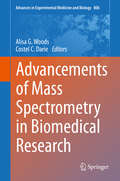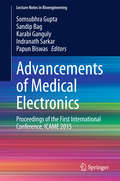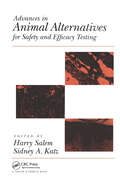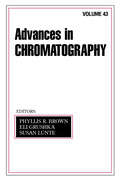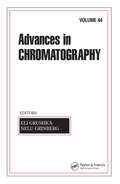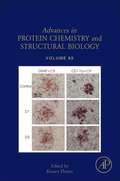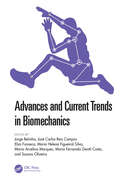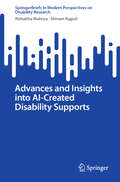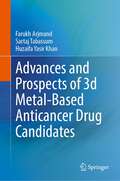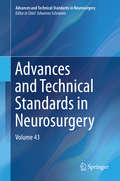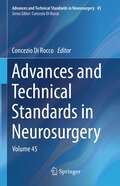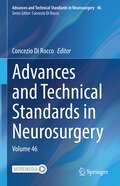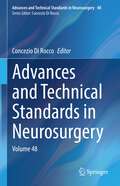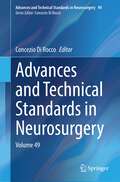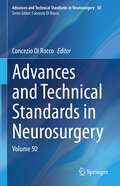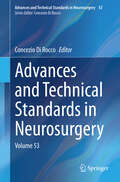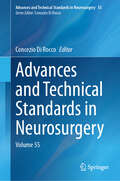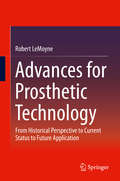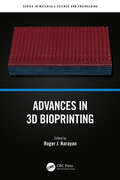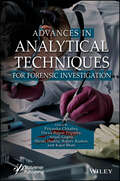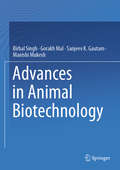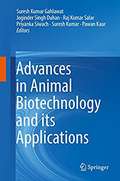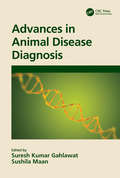- Table View
- List View
Advancements of Mass Spectrometry in Biomedical Research (Advances in Experimental Medicine and Biology #806)
by Alisa G. Woods Costel C. DarieThis volume explores the use of mass spectrometry for biomedical applications. Chapters focus on specific therapeutic areas such as oncology, infectious disease and psychiatry. Additional chapters focus on methodology as well as new technologies and instrumentation. This volume provides readers with a comprehensive and informative manual that will allow them to appreciate mass spectrometry and proteomic research but also to initiate and improve their own work. Thus the book acts as a technical guide but also a conceptual guide to the newest information in this exciting field. Mass spectrometry is the central tool used in proteomic research today and is rapidly becoming indispensable to the biomedical scientist. With the completion of the human genome project and the genomic revolution, the proteomic revolution has followed closely behind. Understanding the human proteome has become critical to basic and clinical biomedical research and holds the promise of providing comprehensive understanding of human physiological processes. In addition, proteomics and mass spectrometry are bringing unprecedented biomarker discovery and are helping to personalize medicine.
Advancements of Medical Electronics: Proceedings of the First International Conference, ICAME 2015 (Lecture Notes in Bioengineering)
by Somsubhra Gupta Sandip Bag Karabi Ganguly Indranath Sarkar Papun BiswasThe book is a collection of peer-reviewed scientific papers submitted by active researchers in the 1st International Conference on Advancements of Medical Electronics (ICAME2015). The conference is organized jointly by the Department of Biomedical Engineering and Electronics and Communication Engineering, JIS College of Engineering, West Bengal, India. The primary objective of the conference is to strengthen interdisciplinary research and its applications for the welfare of humanity. A galaxy of academicians, professionals, scientists, statesman and researchers from different parts of the country and abroad got together and shared their knowledge. The book presents research articles of medical image processing & analysis, biomedical instrumentation & measurements, DSP & clinical applications, embedded systems & its applications in healthcare. The book can be referred as a tool for further research.
Advances In Animal Alternatives For Safety And Efficacy Testing
by Sidney A. Katz Harry SalemPresents up-to-date concepts and approaches to the theory and practice of alternatives to animal testing and promotes technology transfer. The text addresses some of the ramifications of the National Institutes of Health Revitalization Act of 1993 which instructs the NIH to fund replacement, reduction and refinement alternatives. It also describes
Advances In Chromatography: Volume 43 (Advances in Chromatography)
by Eli Grushka Phyllis R. Brown Susan LunteFeaturing reliable, up-to-the-minute reviews of major developments in chromatography, Volume 43 studies the latest advances in the field with contributions and current research from world-renowned leaders in industry. It provides detailed discussions of current topics, issues, and developments in separation science and examining topics such as grad
Advances In Chromatography: Volume 44 (Advances in Chromatography)
by Nelu Grinberg Eli GrushkaFor more than four decades, scientists and researchers have relied on the Advances in Chromatography series for the most up-to-date information on a wide range of developments in chromatographic methods and applications. Volume 44 of this authoritative series once again compiles the work of expert contributors in order to present timely and cutting
Advances In Protein Chemistry And Structural Biology: Inflammation in Neuropsychiatric Disorders Volume 88
by Rossen DonevPublished continuously since 1944, the Advances in Protein Chemistry and Structural Biology serial has been a continuous, essential resource for protein chemists. Covering reviews of methodology and research in all aspects of protein chemistry, including purification/expression, proteomics, modeling and structural determination and design, each volume brings forth new information about protocols and analysis of proteins while presenting the most recent findings from leading experts in a broad range of protein-related topics.
Advances and Challenges in Space-time Modelling of Natural Events (Lecture Notes in Statistics #207)
by José–maría Montero Emilio Porcu Martin SchlatherThis book arises as the natural continuation of the International Spring School "Advances and Challenges in Space-Time modelling of Natural Events," which took place in Toledo (Spain) in March 2010. This Spring School above all focused on young researchers (Master students, PhD students and post-doctoral researchers) in academics, extra-university research and the industry who are interested in learning about recent developments, new methods and applications in spatial statistics and related areas, and in exchanging ideas and findings with colleagues.
Advances and Current Trends in Biomechanics: Proceedings of the 9th Portuguese Congress on Biomechanics, CNB2021, 19 - 20 February 2021, Porto, Portugal
by Jorge BelinhaThis volume presents a collection of peer-reviewed papers on several areas in the field of biomechanics, including biofabrication; biomaterials; cardiovascular biomechanics, biofluids and hemodynamics; biomechanics of the injury/impact; biomechanics of rehabilitation; sports biomechanics; biomechanics of the skull and spine; biomechanics of the musculoskeletal system; biomechanics orofacial; orthopaedic biomechanics; experimental and numerical biomechanics; tissue engineering, and biomedical devices. A collection of novelties and research outcomes presented at the 9th National Biomechanics Congress (CNB 2021, 19-20 February, Porto, Portugal), this book reflects the enthusiasm and intense activity of the Portuguese biomechanical community, as well as the multidisciplinary character of the field. The National Congress of Biomechanics (CNB) is a scientific meeting organized in Portugal under the auspices of the Portuguese Biomechanical Society (SPB).
Advances and Insights into AI-Created Disability Supports (SpringerBriefs in Modern Perspectives on Disability Research)
by Rishabha Malviya Shivam RajputThis book offers a comprehensive exploration of the convergence of generative artificial intelligence and disability assistance, seeking to highlight the revolutionary capabilities of AI technology in improving the lives of those with disabilities. Given the swift progression of AI capabilities, it is vital to comprehend how these innovations might be used to foster inclusivity, enhance accessibility, and deliver personalised assistance. This book aims to connect advanced research and practical applications with the specific requirements of individuals with disabilities. The book offers a detailed investigation of generative AI as an assistive tool for individuals with disabilities, encompassing fundamental principles of generative AI, case studies of effective applications, and critical analyses of ethical considerations and societal implications. The book provides a comprehensive analysis of several applications of generative AI for individuals with disabilities across various domains. Examples of generative AI applications encompass AI-assisted communication tools for individuals with speech problems, customised educational platforms for students with learning challenges, virtual reality settings that improve social engagement for individuals on the autistic spectrum and various others. These applications demonstrate how generative AI may improve accessibility and empower individuals by personalising experiences to their individual requirements.
Advances and Prospects of 3-d Metal-Based Anticancer Drug Candidates
by Farukh Arjmand Sartaj Tabassum Huzaifa Yasir KhanThis book reviews the potential of metallodrugs against different cancer. It summarizes the classification of metal-based anti-cancer drugs, their plausible biochemical and mechanistic pathways, combining drug strategies for hitting multiple therapeutic targets at the intracellular level, and advanced drug delivery strategies. The book covers the metallodrugs for the efficacious treatment of diverse cancerous strains and recent advances in drug delivery strategies that are used for developing these metal-based therapeutics as potent anticancer agents in vitro and in vivo. The book also covers different biophysical and analytical techniques for studying metal-ligand and metal-macromolecular interactions. The book further presents the recent examples of metallomics studies on the different types of cell death induced by metal-based anticancer drugs, especially on the three major forms of programmed cell death (PCD) in mammalian cells: apoptosis, autophagy, and regulated necrosis, alsocalled necroptosis. Lastly, the book explores the modulation of reactive oxygen species (ROS) by metallodrugs.
Advances and Technical Standards in Neurosurgery: Volume 43 (Advances and Technical Standards in Neurosurgery #43)
by Johannes SchrammThis volume of Advances and Technical Standards in Neurosurgery covers some important new developments in functional neurosurgery and endovascular therapy. In the Technical Standards section a variety of topics are considered, including optic pathway gliomas, pineal lesions, cavernous sinus meningiomas and the eternal problem of minor and repetitive head injury. Endovascular treatment of a variety of lesions is now common practice and the state of the art in endovascular treatment for acute ischemic stroke is reviewed. An appraisal of the evidence on whether there is a place for microsurgical vascular decompression for essential hypertension raises interesting questions. The volume is completed by contributions on neurosurgical treatment of cluster headaches and occipital nerve stimulation.
Advances and Technical Standards in Neurosurgery: Volume 45 (Advances and Technical Standards in Neurosurgery #45)
by Concezio Di RoccoThis book offers an update on several basic and clinical problems in neurosurgery compiled by internationally recognized experts. This multi-thematic volume will touch on a variety of topics: from the role of women neurosurgeons in the last hundred year of the specialty history, to the pathogenesis of spinal dysraphism, to the convection-enhanced delivery of intracerebral antineoplastic drugs in children, through a review of methods and applications. The intraoperative cerebral blood flow monitoring in neurosurgery will be also discussed, offering again a comprehensive review of contemporary technologies and emerging perspectives. As for the technical standards, the book will describe the multimodality approach to cerebral gliomas, the management of thalamic tumors, the intracavitary treatment of craniopharyngiomas, the long term results of spasticity treatments, the surgical treatment of spinal vascular malformations, the management of idiopathic and refractory syringomyelia, offering at the same time an update of peripheral nerve surgery. All the chapters have to be considered an advance in the relative fields, in cerebral pathophysiology and in clinical management. Approaching the issue of technical standards in the everyday clinical practice of neurosurgery, this book is of great interest for neurosurgeons, neurologists and orthopaedists.
Advances and Technical Standards in Neurosurgery: Volume 46 (Advances and Technical Standards in Neurosurgery #46)
by Concezio Di RoccoThe book provides an update of several pathological conditions of the CNS that require neurosurgical treatment.The different chapters, written by the most eminent international scientists and clinicians in the field of neuroscience, offer a critical assessment of the relevant nosographic entities that are the subject of current scientific debate.The first chapter critically analyses the new WHO classification of brain tumours, while the second chapter is specifically devoted to intracranial tumours in the first years of life. The technical aspects of neuro-oncological surgery are addressed by two chapters dealing with the suprasellar approach to infratentorial tumours and how to decrease the risk of a specific complication of the surgical management of these tumours in the paediatric population, namely post-operative speech impairment. Hypothalamic tumours with their associated epilepsy and intracranial schwannomas complete the technical surgical section on intracranial tumours. An interesting chapter presents the latest advances in clinical prediction in neurosurgery.Spinal problems are discussed in two chapters, the first considering evolving concepts on craniovertebral and spinal instability and the second Chiari malformations.The management of intracranial arachnoid cysts is still a matter of controversy, as demonstrated in a specific chapter of the book. Another chapter deals with subdural haematomas in both adults and children.Hydrocephalus is treated in two chapters devoted to two post-inflammatory or post-infectious complications leading to specific and difficult-to-treat abnormalities in the CSF circulation.The final chapter of the book illustrates the rationale behind midface advancement in craniosynostosis.As with the previous volume in the series, the present volume represents an important contribution to the advancement of neurosurgical specialties.
Advances and Technical Standards in Neurosurgery: Volume 48 (Advances and Technical Standards in Neurosurgery #48)
by Concezio Di RoccoThis new multithematic book in the series Advances and Technical Standards in Neurosurgery offers an update on several basic and clinical problems in neurosurgery. The main topics are cerebral tumors, epilepsy and vascular malformations. The first chapter will deal with the burden of childhood cancer across the globe, a particular relevant problem in times where economic restrictions and the increased difficulties to access cure are the direct impact of the Covid19 pandemic. A very detailed chapter will provide new guidelines for neuroimaging investigations for intracerebral pathological conditions of surgical interest in the pediatric population. The technical aspects and technological advances in the surgical management of cerebral midline tumors will be covered by several chapters focusing of the optic pathways’ tumors, third ventricle tumors, mesencephalon and pineal body tumors. An update on Chiari malformations and syringomyelia, on the surgical management of epilepsy and on cerebral aneurysms and pediatric spinal vascular malformations will be provided in the remaining contributions. All chapters contribute to an important advancement in the relevant fields, thus offering a valuable contribution to the management of difficult clinical conditions.
Advances and Technical Standards in Neurosurgery: Volume 49 (Advances and Technical Standards in Neurosurgery #49)
by Concezio Di RoccoThe book offers the update on several basic and clinical problems in neurosurgery compiled by internationally recognized experts. The main topics covered are cerebral tumors, epilepsy and vascular malformations, congenital and acquired spine anomalies.The first chapter is devoted to the genetic of the Moya-Moya disease, a cerebral vascular disease quite common in Asia that is not yet sufficiently known. The second chapter is devoted to the current application of VR/AR (virtual reality/augmented reality) to pediatric neurosurgery. The next four chapters discuss the management of spine diseases, respectively the tethered cord syndrome , the severe forms of spondylolisthesis, the role of perioperative checklists, and the long-term outcomes of myelomeningocele. Two chapters deal with the surgical aspects of the management of intraventricular tumors. Cerebral tumors, namely malignant gliomas and jugular foramen tumors are the subject of the remaining chapters.Approaching the issue of technical standards in the everyday clinical practice of neurosurgery, this book of great interest for neurosurgeons, neuroradiologists, vascular and plastic surgeons.
Advances and Technical Standards in Neurosurgery: Volume 50 (Advances and Technical Standards in Neurosurgery #50)
by Concezio Di RoccoIn this book, internationally recognised experts provide an update on some important basic and technical aspects of neurosurgery. Intracranial tumours are the main focus of the book with chapters dealing with ependymomas, a tumour that still offers difficulties of interpretation in terms of both pathological features and management modalities, intraventricular tumours, which require particular attention in the choice of treatment modalities, and tumours considered typically paediatric that may still present in adulthood although with different aspects. Technical approaches to difficult anatomical areas are discussed in three chapters, dealing with the orbit, the craniocervical junction and the brainstem, respectively. Two rather didactic chapters, dealing with the minimally invasive technique for the spine and the clipping of cerebral aneurysms, are intended to contribute to the training of young neurosurgeons by illustrating the surgical steps in detail. The contribution of ultrasound to neurosurgery is illustrated in two chapters that should arouse great interest. The so-called Chiari malformations is approached in a chapter emphasising the role of cranio-cerebral disproportion in their pathogenesis. Finally, a chapter devoted to the ethical attitude that should characterise the daily practice of the neurosurgeon completes the book.Like the previous volumes in the series, this one represents an important contribution to the advancement of neurosurgical specialities.
Advances and Technical Standards in Neurosurgery: Volume 53 (Advances and Technical Standards in Neurosurgery #53)
by Concezio Di RoccoThis book presents a comprehensive update on some crucial aspects of brain and spinal tumoral pathology that strongly influence the current surgical management. It covers a range of topics, from the latest results of molecular diagnosis for tumors still considered unsuitable for surgical excision, to the increasing use of minimally invasive approaches made possible by the wide application of neuroendoscopic techniques. The first three chapters discuss basic research on the potential benefits of new, less invasive and more sophisticated techniques for brain exploration. The following four chapters examine how modern instruments for intraoperative visualization are modifying the traditional paradigm of classical neurosurgery. Two chapters describe he recent understanding of two of the most relevant intracranial tumors that still pose challenges for successful treatment, namely the tumor of the pineal region and ependymomas. Two more chapters are devoted to the management of brain tumors, the first exploring the valuable information that can be derived from biopsy when properly carried out, and the second detailing an innovative therapeutic modality that increases the intratumoral level of antineoplastic agents while minimizing body toxicity and side effects. The book also delves into congenital or acquired malformations of the brain, the skull base, and the cranial vault in three of its remaining chapters. Finally, the last chapter addresses the traumatic pathology of the spine, whose etiology and management have changed significantly in recent years.
Advances and Technical Standards in Neurosurgery: Volume 55 (Advances and Technical Standards in Neurosurgery #55)
by Concezio Di RoccoThis volume maintains the structure of previous ATSN series volumes, offering a balanced distribution of chapters that cover recent advances in neurosurgery and reviews of major neurosurgical conditions.Key sections of the volume provide a detailed review of tumors, including those of the optic pathways, hypothalamus, and pituitary adenomas. These sections highlight the renewed interest in surgical options for these tumors, emphasizing multi-specialist treatment approaches. The initial chapters focus on the development of instruments and techniques that facilitate minimally invasive approaches to various regions of the brain and cranio-vertebral junction. The volume also includes a chapter on colloid cysts of the third ventricle, which complements the discussion of surgical approaches for anterior skull base and frontal basal region pathologies. Other chapters are dedicated to cerebral arterial aneurysms and arteriovenous malformations, exploring the advantages of combined therapeutic strategies for safer and more effective management of these complex lesions. The final chapters investigate the benefits of complete excision of spinal lipomas versus partial resections and the more extensive excision of brain tissue harboring a glioblastoma (lobectomy) versus simple resection of the tumor and its infiltration into the surrounding brain parenchyma. Overall, the book is primarily aimed at mature and experienced neurosurgeons, but it is also beneficial for younger practitioners. It emphasizes a continuous reconsideration of well-known diseases in terms of new approaches that combine increased efficacy with decreased risk for the patient.
Advances for Prosthetic Technology: From Historical Perspective to Current Status to Future Application
by Robert LemoyneThis book focuses on the advances in transtibial prosthetic technology and targets research in the evolution of the powered prosthesis such as the BiOM, which was derived from considerable research and development at the Massachusetts Institute of Technology. The concept of the book spans the historical evolution of prosthetic applications from passive to new and futuristic robotic prosthetic technologies. The author describes the reasons for amputation, surgical procedures, and an historical perspective of the prosthesis for the lower limb. He also addresses the phases and sub-phases of gait and compensatory mechanisms arising for a transtibial prosthesis and links the compensatory mechanisms to long-term morbidities. The general technologies for gait analysis central to prosthetic design and the inherent biomechanics foundations for analysis are also explored. The book reports on recent-past to current-term applications with passive elastic prostheses. The core of the book deals with futuristic robotic prostheses including their function and major subsystems, such as actuator technology, state machine control, and machine learning applications. Finally, the envisioned future trends in the prosthetic technology space are presented.
Advances in 3D Bioprinting (Series in Materials Science and Engineering)
by Roger J. Narayan"3D bioprinting" refers to processes in which an additive manufacturing approach is used to create devices for medical applications. This volume considers exciting applications for 3D bioprinting, including its use in manufacturing artificial tissues, surgical models, and orthopedic implants.The book includes chapters from leaders in the field on 3D bioprinting of tissues and organs, biomedical applications of digital light processing, biomedical applications of nozzle-free pyro-electrohydrodynamic jet printing of buffer-free bioinks, additive manufacturing of surgical models, dental crowns, and orthopedic implants, 3D bioprinting of dry electrodes, and 3D bioprinting for regenerative medicine and disease modeling of the ocular surface.This is an accessible reference for students and researchers on current 3D bioprinting technology, providing helpful information on the important applications of this technology. It will be a useful resource to students, researchers, and practitioners in the rapidly growing global 3D bioprinting community.
Advances in Air Quality Research in Africa: Proceedings of the First International Conference on Air Quality in Africa (ICAQ'Africa 2022) (Advances in Science, Technology & Innovation)
by Abdelwahid Mellouki Khanneh Wadinga Fomba Bertrand Tchanche Fankam Daniel M. Westervelt Michael R. GiordanoThis book presents the recent findings on air quality in Africa from the virtual event of the first International Conference on Air Quality in Africa (ICAQ 2022), providing a comprehensive overview on many subjects of air pollution that affect African society. It highlights research progress in the chemical and physical characterization of air pollutants, their related respiratory and non-respiratory health effects, measurements and monitoring of air pollutants using satellite remote sensing and modeling techniques, currently implemented abatement policies in different African countries, existing research and networking infrastructures, and novel tools for monitoring air quality. The advances in the development of local cost-effective air quality monitoring tools in Africa as well as the use of low-cost sensors in quantifying air quality levels are presented. This book is an enrichment for researchers, experts, and advocates of air quality, atmospheric chemistry and physics, satellite remote sensing applications, and policymakers in Africa.
Advances in Analytical Techniques for Forensic Investigation
by Rajeev Kumar Divya Bajpai Tripathy Anjali Gupta Priyanka Chhabra Shruti Shukla Kajol BhatiThis book is essential for anyone seeking to understand and apply the latest analytical techniques in forensic investigation, saving time, materials, energy, and manpower by providing guidance on the most appropriate techniques for different types of investigations. Advances in Analytical Techniques for Forensic Investigation is aimed to describe the applicability of different types of analytical techniques used for the forensic investigation, including FT-IR, chromatography, mass spectroscopy, NMR spectroscopy, atomic absorption spectroscopy, UV- vis spectroscopy, etc. This book will focus on current and emerging developments in the latest analytical techniques and methods used in the forensic investigation and sample analysis of various physical, chemical, and biological samples in order to facilitate the smooth conduction of justice.
Advances in Animal Biotechnology
by Birbal Singh Gorakh Mal Sanjeev K. Gautam Manishi MukeshThis book entitled, “Advances in Animal Biotechnology,” is a compilation of state-of-the-art in the field of Animal Biotechnology including fishery, that are not sheltered in depth in earlier publications. It offers an update on avant-garde technologies and advances in key aspects of genetic engineering, metagenomics, assisted reproduction, animal genomics, biotechnology in veterinary health, as well as the role of gut and marine microbial ecosystems in livestock and industrial development. The book is divided broadly into five different sections, viz., Gut Microbiome and Nutritional Biotechnology, Assisted Reproduction Biotechnology, Livestock Genomics, Health Biotechnology, and Animal Biotechnology in Global Perspective. The book covers the syllabi of Animal Biotechnology courses in various universities, academia and competitive examinations at various levels. Researchers, Continuing Graduates, and Academicians, Research Institutions, and Biotech Companies will be benefited from this valuable compilation of research. Its broad spectrum makes this work a valuable resource for professionals, researchers, academics and students in the field of veterinary and animal production as well as the biotechnology industry.
Advances in Animal Biotechnology and its Applications
by Suresh Kumar Gahlawat Raj Kumar Salar Priyanka Siwach Joginder Singh Duhan Suresh Kumar Pawan KaurProvides updated information on important and advanced topics of Biotechnology i.e. Drug delivery, Genome editing, Diagnostics, Probiotics, and Nanotechnology.<P><P> Represents comprehensive overview of the interdisciplinary field of Biotechnology.<P> Includes application of Biotechnology in Diagnostics, Therapeutics, and drug discovery.<P>This book explores the recent advancements in cutting-edge techniques and applications of Biotechnology. It provides an overview of prospects and applications while emphasizing modern, and emerging areas of Biotechnology. The chapters are dedicated to various field of Biotechnology including, genome editing, probiotics, in-silico drug designing, nanoparticles and its applications, molecular diagnostics, tissue engineering, cryopreservation, and antioxidants. It is useful for both academicians and researchers in the various disciplines of life sciences, agricultural sciences, medicine, and Biotechnology in Universities, Research Institutions, and Biotech companies. This book provides the readers with a comprehensive knowledge of topics in Genomics, Bionanotechnology, Drug Designing, Diagnostics, Therapeutics, Food and Environmental Biotechnology. The chapters have been written with special reference to the latest developments in the frontier areas of Biotechnology that impacts the Biotech industries.
Advances in Animal Disease Diagnosis
by Suresh Kumar GahlawatAdvances in Animal Disease Diagnosis: Infectious animal diseases caused by pathogenic microorganisms such as bacteria, fungi, and viruses threaten the health and well-being of wildlife, livestock and human populations, limit productivity and significantly increase economic losses to each sector. Pathogen de-tection is an important step for the diagnosis and successful treatment of animal diseases as well as control management in farm and field conditions. The conventional techniques employed to diagnose pathogens in livestock species are time-consuming and sometimes give inconclusive results. On the contrary, molecular techniques have the potential to diag-nose known pathogens/conditions quickly, reliably, and unequivocally as well as for novel pathogen detection. New advances in diagnostics and vaccine design using genomics have developed powerful new methods that have also set the stage for the enhanced diagnosis, surveillance, and control of infectious diseases. High-throughput sequencing (HTS), for ex-ample, uses the latest DNA sequencing platforms in the detection, identification, and detailed analysis of both pathogen and host genomes. This book will explore some key opportunities in the context of animal health, such as the detection of new microorganisms and the development of improved diagnosis of emerging or re-emerging diseases and other clinical conditions, viz. biosensors, nanotools, and omics technologies. Features • Details comprehensive knowledge on the latest molecular techniques for animal disease diagnosis and management• Examines how DNA-based diagnostic techniques will assist international efforts to control the introduction of exotic diseases into new geographic areas• Describes the latest molecular assays for the rapid and accurate detection of pathogens• Helps in working towards meeting the global challenge for sustainable food production and the eradication of poverty• With new biotechnological developments, this fully updated book is a treasure trove of the latest information in animal and medical science
